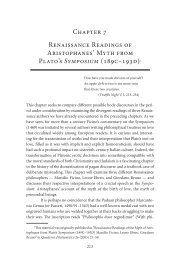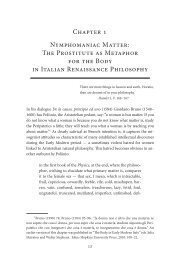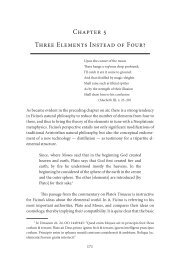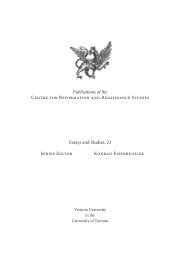Chapter 2 Matter as a Mirror: Marsilio Ficino and Renaissance ...
Chapter 2 Matter as a Mirror: Marsilio Ficino and Renaissance ...
Chapter 2 Matter as a Mirror: Marsilio Ficino and Renaissance ...
Create successful ePaper yourself
Turn your PDF publications into a flip-book with our unique Google optimized e-Paper software.
<strong>Matter</strong> <strong>as</strong> a <strong>Mirror</strong> 83<br />
gins. 111 The motif of three mirrors reflecting the ide<strong>as</strong> or archetypes in varying<br />
degrees of refinement is also present in the Anticlaudianus of Alain de Lille<br />
(c. 1123–1202). This text mentions a gl<strong>as</strong>s mirror where the forms appear<br />
mixed with subjects; a silver mirror, which reflects primordial matter <strong>as</strong> well<br />
<strong>as</strong> forms in their purer state; <strong>and</strong>, l<strong>as</strong>tly, a looking gl<strong>as</strong>s made of gold in which<br />
the ide<strong>as</strong> themselves can be perceived. 112 In a similar vein, in his Theologia,<br />
<strong>Ficino</strong> speaks about images that are impressed into an eternal mirror. 113 In<br />
Dante’s Divina commedia the idea of a hierarchy of mirrors that reflect the<br />
image of God on a lower level appears in a different context; here the mirrors<br />
do not render a darker image (<strong>as</strong> in <strong>Ficino</strong>) but a smaller one. 114<br />
At this point it is perhaps fair to mention another author who is<br />
often seen in connection with <strong>Ficino</strong>: the idea of a living mirror (speculum<br />
vivens) is present in Cusanus (Nichol<strong>as</strong> of Kues or of Cusa, 1401–64), though<br />
again in a slightly different context. According to Cusanus, all created things<br />
are mirrors whose curved <strong>and</strong> irregular surfaces are incapable of adequately<br />
representing the divine image of truth. Only the mirror of the human mind<br />
h<strong>as</strong> the capacity to remodel itself into such a perfect surface, to smoothen out<br />
all the distortions <strong>and</strong> finally adequately to reflect the divine truth. 115 The im-<br />
111 According to Goldberg (1985) 242, the Roman de la rose (c. 1273) uses a strikingly<br />
similar concept: “Jean de Meun used the mirror <strong>as</strong> a symbol of human reproduction, tying<br />
it analogously to the chain of being. The chain of being can be considered <strong>as</strong> a chain of<br />
mirrors dependent from God, the successive members of which reflect God’s image with<br />
less <strong>and</strong> less distinctiveness. On a lesser scale, the reflection of an image within a mirror<br />
is a distinct analogy to reproduction. As a son is called „the image of his father,” so all<br />
God’s creatures […] may be called his images. The mirror, therefore, which symbolizes<br />
the radiant source of life also symbolizes the process of generation of the individual. Jean<br />
de Meun’s ulterior aim is to encourage man to generate true <strong>and</strong> living images of God. To<br />
emph<strong>as</strong>ize his purpose, he ch<strong>as</strong>tises those who generate false <strong>and</strong> lying images, […]. He<br />
<strong>as</strong>ks the reader to enter the world of true <strong>and</strong> faithful images, each of which is reflected<br />
from the ever-luminous mirror which is the mind of God.”<br />
112 See Dronke (1974) 148 n. 2 with references.<br />
113 Theologia, V, 13: I, 209. Giordano Bruno uses the metaphor of a speculum videns<br />
in his Summa terminorum metaphysicorum, OL I; IV 31–32.<br />
114 Dante, Paradiso, II, 97–105. On this, see Miller (1977) 266–268 <strong>and</strong> 266: “Creation<br />
becomes a hierarchy of mirrors, each ch<strong>as</strong>ing an image of god. The further off the<br />
individual mirror is from god, the smaller the image of him it reflects, but his brightness<br />
never diminishes.”<br />
115 Kues (1967) 69 : I: 192–193 on the concept of distorted mirrors.







